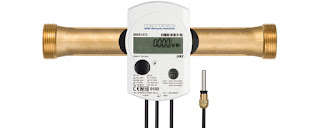 |
| Ultrasonic In-line Thermal Energy Meter Courtesy Micronics |
We live in a society of buildings, each with a mapped out function. Most buildings are predominantly occupied by people, bringing a requirement to maintain temperature, relative humidity, and air quality at levels of suitable comfort for human occupants. The energy consumption involved with providing that level of comfort stands as a bold line item in the operating expense ledger for any building. That is where accountability and efficiency come in. It is in the building stakeholders' interest to have knowledge regarding rates and quantity of thermal energy usage, as well as efficiency measures of delivered output per unit of input energy.
HVAC (Heating, Ventilation, Air Conditioning) primarily is an endeavor that generates and moves thermal energy throughout an enclosed space. Commercially available technology now allows a building operator to accurately measure that movement of thermal energy throughout a system or building. The process is generally called BTU metering and has a number of justifiable benefits.
- Real time equipment performance measurement.
- Sub metering can indicate specific areas of consumption.
- Ability to directly bill multiple tenants in a single building for their thermal energy usage.
- Monitor and balance energy flows.
BTU metering essentially involves inlet and outlet temperature measurement of heat transfer liquids, along with their flow rate. While the principle is simple, the intricacies of the measurement methods and equipment accuracy can have a substantial impact on the accuracy, and thus the benefit, of the measurement data. Additionally, adding more instrumentation to an already complex system can create an additional on-going maintenance and calibration burden to retain the necessary levels of accuracy and function. Success at gaining the benefit of the performance data while minimizing the additional maintenance burden due to the instrumentation should be the goal.
One solution calls for the use of clamp on or in-line ultrasonic flow meters to measure liquid flow, coupled with temperature measurement in a single unit that will perform necessary calculations and provide output data in useful engineering units. An overarching benefit of the clamp on meter is its non-invasive nature, allowing its retrofit to in-place systems with no disturbance to existing piping. Here are some other characteristics of a highly effective BTU measurement unit:
- No wear mechanism as part of the flow measurement unit
- Traceable accuracy of flow and temperature measurements
- Simple installation in new or retrofit applications without disruption to system operation
- Reliable and maintenance free operation
- Accurate measurement from near zero flow rate to maximum system flow
- Stable sensing with no zero drift
- Communications protocol to match building energy management system
- Large storage cache for data, in case of communication failure
- Common output signals, 4-20 ma or other, usable with selected ancillary equipment